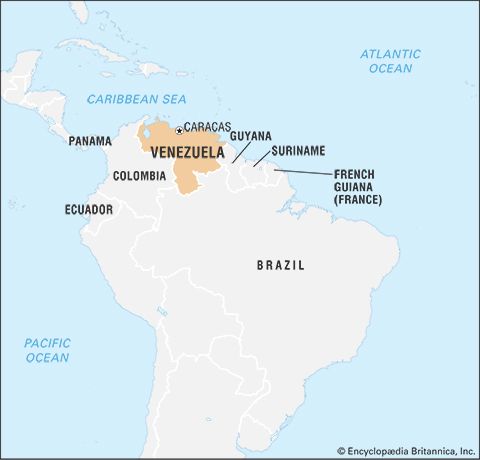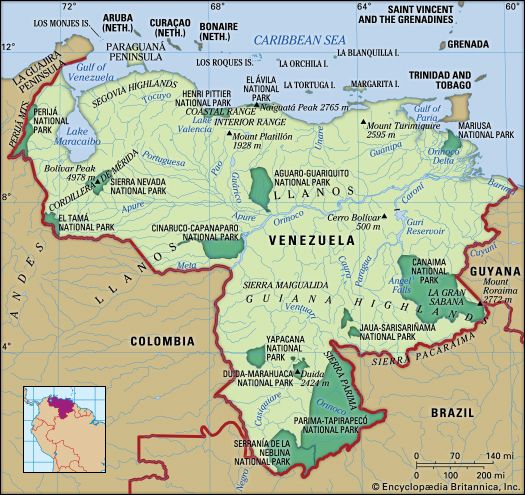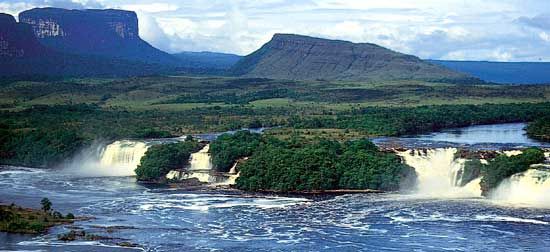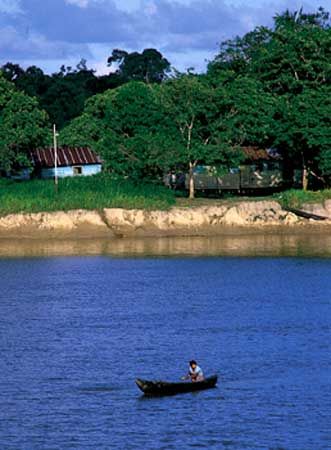Our editors will review what you’ve submitted and determine whether to revise the article.
News •
At the beginning of the 21st century, the service sector accounted for about half of GDP and provided more than half of employment; finance and trade each produced about one-sixth of GDP. Tourism became a growing component of Venezuela’s economy and was focused on the country’s cultural sites, beaches, and natural wonders, such as the tepuis of the Guiana Highlands and the world-famous Angel Falls.
Finance
Since 1958 the government has played a key role in the operation of Venezuela’s financial system, largely through its management of the Central Bank of Venezuela, which sets interest rates, regulates the money supply, issues currency (the bolívar fuerte), and grants loans to commercial banks. Other state banks include the Industrial Bank of Venezuela, the Workers’ Bank of Venezuela, and various regional banks. There are several privately owned commercial and investment banks, as well as insurance companies. Most of these institutions, as well as the national stock exchange, are based in Caracas.
Venezuela was a leader in founding the Organization of Petroleum Exporting Countries (OPEC), and it signed the agreement in 1960 that led to the creation of the organization. When OPEC raised oil prices more than 400 percent in 1973–74, the country received windfall profits, and its oil income rose dramatically until the early 1980s. The huge oil revenues vastly increased Venezuelan influence in Latin America, and the country negotiated favourable trade agreements to supply its neighbours with oil and natural gas. Venezuela has also helped to finance international cartels in such other commodities as bananas and coffee.
Venezuela experienced severe economic problems following the Latin American debt crisis of 1982 and the collapse of world oil prices in 1986. Among its pressing concerns were a foreign-exchange crisis, the loss of international reserves, slowed economic growth, and rising inflation. In response to these issues, Venezuela in 1989 signed agreements with the International Monetary Fund (IMF) and the World Bank that were designed to stabilize the economy. The balance of payments and other factors subsequently improved, and the state again increased its expenditures. However, many of the country’s financial problems returned during the 1990s, brought on by fluctuating oil prices, political instability, a banking crisis in 1994, and mismanagement and overborrowing from the Central Bank. The government subsequently sold off many financial institutions, and by the end of the 1990s foreign investors controlled more than half of Venezuela’s banks.
The government was forced to institute additional stabilization measures, including the Agenda Venezuela plan (1996) that removed some financial controls and privatized several industries. These measures were only partially successful: state expenditures remained high, and oil price fluctuations continued to have dramatic effects on the economy. Venezuela had the highest rate of inflation in Latin America at the beginning of the 21st century; in an attempt to control it and to simplify financial transactions, the country introduced a new currency, the bolívar fuerte (“strong bolívar”), in 2008. On the other hand, in the early 2000s the economy had rebounded enough for Venezuela to have paid off its loans to the IMF and World Bank. Moreover, determined to assert its economic independence, the country withdrew from both organizations in 2007.
The collapse of world oil prices in 2014 sent the Venezuelan economy reeling and initiated a prolonged period of plummeting GDP, hyperinflation, endemic shortages of food and medicine, and political instability. Widely criticized abroad for its increasingly autocratic rule, the government of Pres. Nicolás Maduro sought to right the economy in the face of international economic sanctions. In February 2018 it introduced the petro, a cryptocurrency (similar to Bitcoin) whose value was tied to the price of one barrel of Venezuelan crude oil and was backed by the country’s reserves of gas, oil, gold, and diamonds. In August, against IMF projections that inflation would top one million percent by year’s end, the government re-denominated the currency, lopping five zeroes off the strong bolívar, which it renamed the bolívar soberano (“sovereign bolívar”). As the United States and other Western democracies sought to isolate Venezuela economically as part of a “maximum pressure” campaign to dethrone the Madura regime, Venezuela’s dependence on Russia and China for financial support and loans grew. Russia in particular became Venezuela’s lender of last resort, and its involvement in Venezuelan affairs increased.
Trade
The main feature of Venezuela’s external trade continues to be oil, which represents some nine-tenths of export earnings. Venezuela is a member of Mercosur (formerly known as the Latin American Integration Association), though it withdrew from the Andean Community in 2006. Prior to the souring of U.S.-Venezuelan relations during Maduro’s rule, the United States traditionally was Venezuela’s primary trading partner; other trading partners included Brazil, Colombia, China, Switzerland, the Netherlands, and Argentina. After Venezuela’s access to many of the world’s markets was blocked by sanctions against the Maduro regime, the country’s trade was reoriented largely toward a core of countries that included China, Russia, Cuba, Turkey, and Iran.
Transportation
The country’s transportation system is well developed, especially in the densely populated northern and northwestern regions. Domestic travel depends largely on roads, while freight and bulk transport is largely served by coastal shipping routes, inland waterways, and oil and natural gas pipelines. Air services provide access to regions without other means of communication.
The country maintains approximately 22,400 miles (36,000 km) of paved roads. There are three major trunk roads—a section of the Pan-American Highway that runs southwestward from Caracas through Valencia and Barquisimeto to San Cristóbal and then into Colombia; the northwestern highway, which runs from Valencia to Coro and on to Lake Maracaibo; and the Llanos Highway, which extends eastward from Caracas to Barcelona, Cumaná, and beyond. A branch also runs from Barcelona across the Llanos to Ciudad Bolívar. Bus routes connect most Venezuelan towns and cities. Highways can be dangerous, particularly in the evening: drivers rarely use headlights, and unlighted repairwork, livestock on the road, and other hazards are common.
Railways, both for passenger and freight transport, are relatively unimportant. One public line runs northeastward from Barquisimeto to Puerto Cabello on the coast and on to Caracas. Private railways serve the iron and steel industry, connecting mines in the Guiana Highlands region to Ciudad Guayana.
Almost all the country’s foreign commerce is carried by sea. The most important ports are Maracaibo (a major shipment centre for crude oil), Puerto Cabello, and La Guaira (the port of Caracas). Many small ports serve fishing fleets or coastal trade. Inland waterways are utilized principally around Lake Maracaibo and on the Orinoco River. A dredged channel between the Gulf of Venezuela and Lake Maracaibo allows oceangoing vessels to dock at the ports of Maracaibo, Bobures, and La Salina. A dredged channel through the Orinoco delta permits vessels to sail upriver to Ciudad Guayana.
Transoceanic and intercontinental air routes use Venezuelan international airports as a stopover. Simón Bolívar Airport, located at Maiquetía 10 miles (16 km) by road from Caracas, is the busiest, servicing international and domestic flights.
Administration and social conditions
Government
The Venezuelan constitution of 1999 prescribes a government based on republican, democratic, and federalist principles. Citizens age 21 and older are eligible to vote. All males have had this right since 1872, but universal suffrage was not instituted until 1946. The government is divided into executive, legislative, and judicial branches. During the period 1961–99, the constitution prescribed a government led by a directly elected president, who served a single five-year term, as well as a popularly elected bicameral legislature and a multitiered judicial branch headed by the Supreme Court. As economic difficulties mounted during the 1980s and ’90s, so, too, did criticism of political corruption. In 1999 Hugo Chávez Frías, the newly installed president, pushed for radical reforms, and a constituent assembly was soon elected to draft a new constitution; it was adopted by referendum in December of that year. The constitution was modeled on that of the Fifth French Republic. It fundamentally changed the executive and legislative branches by granting heightened powers to the president and reorganizing the legislature into a unicameral assembly; it also reformed the judiciary system, promised to expand personal liberties, formally acknowledged the rights of indigenous peoples, and changed the country’s name from Republic of Venezuela to Bolivarian Republic of Venezuela.
Executive power is vested in the president, who serves a six-year term and is eligible for reelection. As is typical among Latin American nations, the president wields a greater amount of power than either the judicial or legislative branches of government. In addition to acting as the head of state, the president is the commander in chief of the armed forces. The president appoints an executive vice president and a Council of State, the members of which act as advisers and ministers.
The unicameral National Assembly (Asamblea Nacional) consists of 167 members (deputies) who are popularly elected through a combination of proportional and direct representation, including three deputies elected by the nation’s indigenous peoples. Deputies serve five-year terms. The National Assembly creates laws, authorizes national expenditures, approves treaties, designates foreign ambassadors, and serves numerous other functions. Under certain circumstances the president may dissolve the assembly.
Civil and human rights are protected by an independent judiciary that is organized nationally, with no autonomous state courts. At the highest court level is the Supreme Court of Justice (Tribunal Supremo de Justicia), which adjudicates civil, criminal, and political cases. Its members are nominated by a civil commission and appointed to 12-year terms by the National Assembly. Venezuelans generally enjoy a high degree of individual liberty, but protests have grown over the lack of equal civil and human rights protection for the nation’s indigenous population.
Presidential and legislative elections are contested by several political parties, whose existence is guaranteed by the constitution; two major parties dominated Venezuelan politics until 1993: Democratic Action (Acción Democrática) and the Social Christian Party (Partido Social Cristiano; COPEI). In the 1998 presidential elections, these parties virtually collapsed, and the main presidential contenders represented new political movements. Chávez headed the Movement of the Fifth Republic (Movimiento de la Quinta República; MVR) until 2007, when it was replaced by Chávez’s new political party, the United Socialist Party of Venezuela (Partido Socialista Unido de Venezuela; PSUV).
The country is divided into 23 states and the federal district, which includes Caracas. Each state is headed by a directly elected governor and has a legislative assembly. The assemblies are unicameral bodies composed of representatives from each of the state’s districts. The federal district is administered by a mayor, and the day-to-day administration of local affairs elsewhere in the country is the responsibility of municipal councils and directly elected mayors.






















